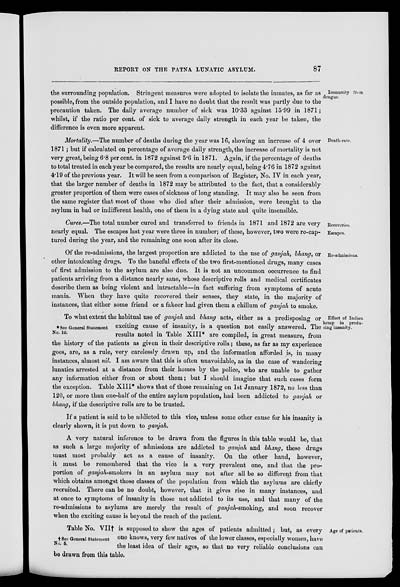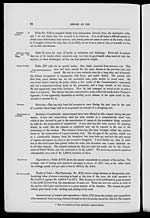Medicine - Mental health > 1867-1924 - Annual report of the insane asylums in Bengal > Insane asylums in Bengal annual reports 1867-1875 > Annual report on the insane asylums in Bengal for the year 1872
(599) Page 87
Download files
Individual page:
Thumbnail gallery: Grid view | List view

REPORT ON THE PATNA LUNATIC ASYLUM. 87
Immunity from
dengue.
the surrounding population. Stringent measures were adopted to isolate the inmates, as far as
possible, from the outside population, and I have no doubt that the result was partly due to the
precaution taken. The daily average number of sick was 10.33 against 15.99 in 1871;
whilst, if the ratio per cent. of sick to average daily strength in each year be taken, the
difference is even more apparent.
Death-rate.
Mortality.—The number of deaths during the year was 16, showing an increase of 4 over
1871; but if calculated on percentage of average daily strength, the increase of mortality is not
very great, being 6.8 per cent. in 1872 against 5.6 in 1871. Again, if the percentage of deaths
to total treated in each year be compared, the results are nearly equal, being 4.76 in 1872 against
4.19 of the previous year. It will be seen from a comparison of Register, No. IV in each year,
that the larger number of deaths in 1872 may be attributed to the fact, that a considerably
greater proportion of them were cases of sickness of long standing. It may also be seen from
the same register that most of those who died after their admission, were brought to the
asylum in bad or indifferent health, one of them in a dying state and quite insensible.
Recoveries.
Escapes.
Cures.—The total number cured and transferred to friends in 1871 and 1872 are very
nearly equal. The escapes last year were three in number; of these, however, two were re-cap-
tured during the year, and the remaining one soon after its close.
Re-admissions.
Of the re-admissions, the largest proportion are addicted to the use of ganjah, bhang, or
other intoxicating drugs. To the baneful effects of the two first-mentioned drugs, many cases
of first admission to the asylum are also due. It is not an uncommon occurrence to find
patients arriving from a distance nearly sane, whose descriptive rolls and medical certificates
describe them as being violent and intractable—in fact suffering from symptoms of acute
mania. When they have quite recovered their senses, they state, in the majority of
instances, that either some friend or a fakeer had given them a chillum of ganjah to smoke.
Effect of Indian
hemp in produ-
cing insanity.
* See General Statement
No. 10.
To what extent the habitual use of ganjah and bhang acts, either as a predisposing or
exciting cause of insanity, is a question not easily answered. The
results noted in Table XIII* are compiled, in great measure, from
the history of the patients as given in their descriptive rolls; these, as far as my experience
goes, are, as a rule, very carelessly drawn up, and the information afforded is, in many
instances, almost nil. I am aware that this is often unavoidable, as in the case of wandering
lunatics arrested at a distance from their homes by the police, who are unable to gather
any information either from or about them; but I should imagine that such cases form
the exception. Table XIII* shows that of those remaining on 1st January 1872, no less than
120, or more than one-half of the entire asylum population, had been addicted to ganjah or
bhang, if the descriptive rolls are to be trusted.
If a patient is said to be addicted to this vice, unless some other cause for his insanity is
clearly shown, it is put down to ganjah.
A very natural inference to be drawn from the figures in this table would be, that
as such a large majority of admissions are addicted to ganjah and bhang, these drugs
must most probably act as a cause of insanity. On the other hand, however,
it must be remembered that the vice is a very prevalent one, and that the pro-
portion of ganjah-smokers in an asylum may not after all be so different from that
which obtains amongst those classes of the population from which the asylums are chiefly
recruited. There can be no doubt, however, that it gives rise in many instances, and
at once to symptoms of insanity in those not addicted to its use, and that many of the
re-admissions to asylums are merely the result of ganjah-smoking, and soon recover
when the exciting cause is beyond the reach of the patient.
Age of patients.
† See General Statement
No. 5.
Table No. VII† is supposed to show the ages of patients admitted; but, as every
one knows, very few natives of the lower classes, especially women, have
the least idea of their ages, so that no very reliable conclusions can
be drawn from this table.
Set display mode to: Large image | Zoom image | Transcription
Images and transcriptions on this page, including medium image downloads, may be used under the Creative Commons Attribution 4.0 International Licence unless otherwise stated. ![]()
| Permanent URL | https://digital.nls.uk/83379797 |
|---|



![[Page 86]](https://deriv.nls.uk/dcn4/8337/83379796.4.jpg)
